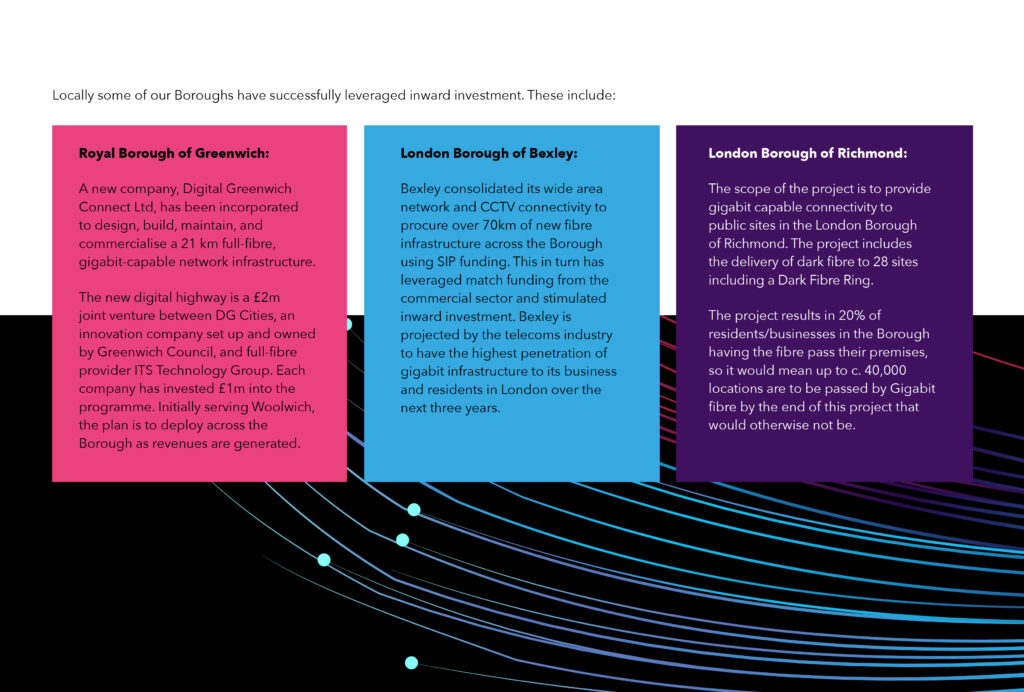Over 150,000* premises in south and east London do not have access to high speed – Gigabit capable – internet connections.
Contrary to perception, hundreds of thousands of addresses in London are affected by slow digital connectivity, causing digital inequalities that impede the lives of people and businesses.

The ‘Sub-regional Digital Infrastructure Strategy’ launched today by Local London and the South London Partnership, identifies gaps in 14 south and east London boroughs. It includes recommendations for driving up the quality and accessibility of services in them and will help channel investment to areas of economic opportunity.
With an estimated population of 3.8 million, Local London and South London Partnership are two of London’s four sub-regions, representing the interests of the boroughs of Barking and Dagenham, Bexley, Bromley, Enfield, Greenwich, Havering, Newham, Redbridge, Waltham Forest, Croydon, Kingston-upon-Thames, Merton, Richmond-upon-Thames and Sutton.

There are over 103,000 premises in Local London and 53,000 in the South London Partnership sub-region unable to obtain a Gigabit capable broadband service with many sitting in a ‘not spot,’ unable to receive even a 30 Mbps service.
Mapping out the digitally poor postcodes, the strategy highlights best practices, learning and actions that the public and private sector can take together to build world-leading digital infrastructure for some of the fastest growing parts of London.
Commissioned by the Mayor of London’s Infrastructure Coordination Service, the ‘Sub-regional Digital Infrastructure Strategy’ is part of a wider pilot which will deliver an interactive mapping tool and an online digital toolkit that will assist borough officers to deliver digital infrastructure to their sites and leverage additional commercial digital infrastructure investment in the sub-regions.
The ‘Sub-regional Digital Infrastructure Strategy’ provides a compelling argument for actively pursuing digital investment along with step-by-step guidance to public sector officers to attract investment and promote better quality and more accessible services, including:
- Map and statistics illustrating clearly where poor digital infrastructure issues lie.
- Recommendations for public sector resourcing and roles, industry engagement, procurement options and commercial models, and key components of a successful delivery strategy.
- Case studies and examples from across the UK demonstrating successful ways of working and benefits gained.
- The strategic, commercial, financial, management case and options analysis.
Theo Blackwell MBE, Chief Digital Officer, Greater London Authority said “Widely available, easily accessible digital connectivity is essential for people to reach public services and is key to helping cities grow through driving innovation and the creation of new businesses.

“Yet there are still parts of London that suffer from a lack of commercial investment in digital infrastructure, and this results in gaps in internet coverage or ‘not spots’.
“We must address these gaps and drive up the quality and accessibility of the services that are already available, to help the capital to be a fairer, more prosperous, and more equal London for everyone.”
Cllr Baroness O’Neill of Bexley OBE, Chairman of Local London and Leader of London Borough of Bexley said “We are delighted to launch the ‘Sub-regional Digital Infrastructure Strategy’ with our colleagues at South London Partnership. This provides step-by-step guidance to public sector colleagues for unlocking inward investment and maximising existing infrastructure to benefit people and businesses in the area. Along with the database and digital toolkit, this pilot approach will help all 14 boroughs tackle the digital divide, whilst also creating a legacy of learning that have even wider benefits.”
Cllr Gareth Roberts, Chair, South London Partnership and Leader of London Borough of Richmond upon Thames Council commented “This joint strategy demonstrates the benefits of a cross-boundary approach. Addressing the issues at a sub-regional level, with colleagues at Local London, this strategy provides clear guidance for unlocking rapid deployment of next generation wireless infrastructure and gigabit capable full fibre, to align us with other urban areas in the UK, whilst responding to the distinct social and economic needs of each borough.”
Find out more: londondigitaltoolkit.org.uk
*Figures based Ofcom Connected Nations research published December 2023.







Recent Comments